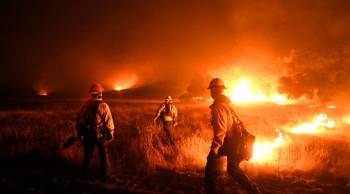Despite wildfires, more homes built in forests
Living in the forest is an expensive proposition, and not just for the homeowners who sign the mortgage checks. The destructive wildfires that have raged through the West in recent years have cost tens of millions of dollars to fight, and resulted in hundreds of millions of dollars in insurance claims. But public policies, and the human desire for a retreat in the trees, means more and more homes than ever are going up in the country’s most fire-prone areas.
For Colorado resident Ben Robinett, who lost his home to last month’s Black Forest Fire, there were plenty of reasons to move his family up to the country.
“It’s always 10 degrees cooler up here than in Colorado Springs and you can hear the trees blowing and the birds chirping. So it’s nice. I liked it,” says Robinett, taking a break from sorting through the rubble. The birds are gone and so are those pleasant temperatures; the sun beats down unhindered through the blackened spikes of pine trees.
Robinett’s desire to live in the forest is shared by a lot of his fellow Coloradans. A recent report found in the past two decades, around a quarter million people moved into “red zones” — the state’s most fire-prone areas. Today, one in four Colorado homes is at high fire risk, according to the investigative news organization, iNews.
“I don’t think people quite realize that they are, we all are, paying for people to live in these types of neighborhoods,” says University of Colorado environmental policy expert Gregory Simon. The costs of wildfires are spread so widely through society that they’re often easy to overlook. Every taxpayer chips in a few pennies to cover firefighting efforts and homeowners all pay a bit extra in their premiums for massive damage claims.
But on the other side, Simon argues that there are clearly some who benefit from forest development, and it’s not just the landowners. Permitting homes on land that used to just be trees is a money-maker for perpetually cash-strapped local governments.
“They do have an incentive to build these developments in areas that will create high property values,” says Simon. “So a lot of these areas are comprised of large homes, with great views, and quite often packed in pretty tightly, for the purposes of generating revenues for cities and counties.”
Officials across the West struggle with how to make sure forest homeowners have some skin in the game when it comes to defending their property. In California, lawmakers two years ago created a controversial “Fire Prevention Benefit” fee to fund things like brush removal and forest management. Homeowners who live near areas where the state is responsible for firefighting have to pony up the $150 fee annually.
In Colorado, a state taskforce is weighing something similar, but the idea faces an uphill climb. Top-down mandates have never been this state’s style, Governor John Hickenlooper, a Democrat. Instead, Hickenlooper wants to see more voluntary fire protection efforts, things homeowners can do themselves, like clearing trees.
“It’s like a lot of things, we have to hit people over the head, but it doesn’t mean the state should be dictating or usurping the local role there,” says Hickenlooper. But as the price tag for fire-fighting keeps getting higher, states like Colorado may have to rethink what role they play in promoting the vision of that idyllic home in the woods.
There’s a lot happening in the world. Through it all, Marketplace is here for you.
You rely on Marketplace to break down the world’s events and tell you how it affects you in a fact-based, approachable way. We rely on your financial support to keep making that possible.
Your donation today powers the independent journalism that you rely on. For just $5/month, you can help sustain Marketplace so we can keep reporting on the things that matter to you.


















